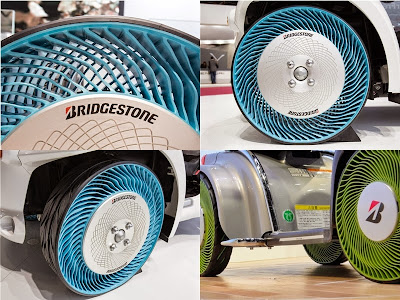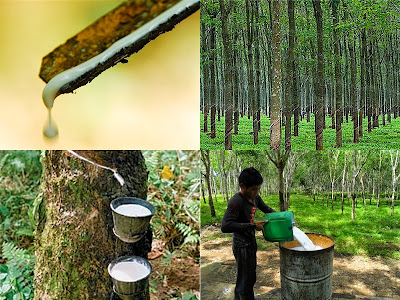All-Electric
Vehicle Sales are still growing at a rapid pace of 33% per annum according to
the stats of Vehicle Sales analyst InsideEVS
as detailed in my blog article
entitled “InsideEVS
stats says All-Electric Vehicles Growing Strong - 500,000 by 2020 is a
potential Robotic Self-Driving Army”.
Growth
may be spurred by the idea that these vehicles would help many consolidate
their Utility bills into just electricity alone. Well, what if you could also
eliminate the flat Tyre and make tyres recyclable?
 |
That's
the promise of never having to touch another Car Tyre again was being touted by
Bridgestone's
Air Free Tyre which they showed off at the Paris Motor Show in October 2013
as declared in the article “Out
with the air: Bridgestone shows off tires you never have to inflate”,
published October 3, 2014 10:17 AM PDT by Stephen Shankland, CNET News.
Originally
introduced back in 2011, this is their second generation prototype that's improved
on previous design with improved heat dissipation capabilities that enable it to
better absorb shocks while driving.
So
how does the Bridgestone's
Air Free Tyre achieve this?
Bridgestone's Air Free Tyre
– Steam Turbine design improves on the air-inflated donut Tyre
It
replaces the conventional Tyre with a design that looks like a Tyre in terms of
being donut shaped.
It
makes it departure from that trusted designed by simply not having to be inflated
with air, which in the Bridgestone
Air Free Tyre is replaced by an arrangement of shock-absorbing material in
a pattering resembling the fans inside of a Steam Turbine Generator.
These
vanes radiate from the center, likes spokes from a bicycle that finally terminate
on a thick band of replaceable Rubber. When the Rubber part of the Tyre wears
out, a new Rubber band can be heated and slipped on in much the same way you
slip on a pair of slippers.
 |
While
Bridgestone Air Slippers might be a bit too girly, it does have some manly
advantages, such as the fact that the tyres have a profile akin to an F1Racing Car
Tyre. Still it has at least four to five (4-5) years of development before even
a price or a working prototype can be tested on real-world vehicles.
Albeit
it cannot be puncture as it has no air, it still has the problem of lateral
stiffness, making it hard to do donuts, wheelies or very hard turns with these
tyres. Which is just as well, as the initial test run of the Bridgestone's
Air Free Tyre will be on All-Electric Vehicles in Tokyo, Japan says Manager
of Bridgestone's technical department for France Benelux. Olivier Monbet.
But
making your car tyres look like F1 Racing treads isn't the main reason why
Bridgestone is still pushing ahead with research on airless tyres after some
five (5) years of testing. It really has to do with recyclability.
If they're worried about recyclability of Rubber, it hints at something else
more sinister; we may be running out of Rubber from as far back as 2010 as
noted in the “Bridgestone,Goodyear Face Deepening Rubber Shortage”, published Sep 21, 2010 5:45 AM ET
By Aya Takada and Supunnabul Suwannakij, Bloomberg.
Bridgestone's Air Free Tyre
– Why minimalistic Design for Recycling says we’re running out of Rubber
Bridgestone
has some eight (8) Tyre manufacturing plants all around the world.
So
with so many factories, they'd be in a position to notice any strange changes
in the Rubber market. They’d naturally have an interest to make sure that
making tyres was a sustainable activity if they suddenly noticed that the demand
for tyres was pushing up the price of Rubber as noted in the article “Tyre
makers wary of Rubber shortage”, published March 13, 2014, Global Rubber Markets.
 |
This
shortfall in supply of Rubber would be an early sign that the Pará rubber trees (Hevea brasiliensis) that produce Rubber,
mainly found in South America with the largest producers being Thailand and
Indonesia are not producing enough Rubber to keep up with Global Tyre Demand. More
land space being cleared may be resulting in the destruction of large tracts of
land with Pará rubber trees (Hevea brasiliensis) for food cultivation.
Coincidentally,
these are countries that are experiencing a prolonged drought cause by Climate
Change coupled with increasing demand from Developing and Developed countries
that’ll result in a global shortage in Chocolate by 2020 as predicted in my blog article
entitled “Chocolate
Shortage in 2020 – Chinese, Indian and American addiction Inflates Price of
Cocoa as Jamaica needs to produce Chocolate”.
According
to the UNFAO (United Nations Food and Agriculture Organization), more land will
be needed to feed the world population which is expected to balloon to 9
billion people by 2030, putting insects and other sources of protein on the
menu as prophesied in my blog article
entitled “United
Nations Food and Agriculture Organization says Insects is the Meat for the next
20 years - Soylent Green may be avoided via Indiana Jones and the Temple of
Doom”.
Growing demand for
Tyres not sustainable – Tyre Manufacturers silently switching from Rubber
This
demand for Rubber to make new tyres is growing as more people learn to drive
and desire to have their own set of wheels, be the Combustion Engine Otto Cycle
vehicles or the All-Electric Vehicle Craze now sweeping the First and Developed
World Countries according to the stats of Vehicle Sales analyst InsideEVS as detailed in my blog article
entitled “InsideEVS
stats says All-Electric Vehicles Growing Strong - 500,000 by 2020 is a
potential Robotic Self-Driving Army”.
Recycling
of Car tyres in the US of A seems to mainly involve turning the Tyre into Diesel
and Gasoline and extracting Carbon as pointed out in my blog article
entitled “St.
Lucia’s SLSWMA to make Fuel from Tyres - Why is Jamaica not converting Tyres at
Riverton City Dump into Fuel”. A Tyre that can’t be pyrolyzed into fuel
would be very attractive, as once it’s worn down, it could be returned to be
refitted with a Rubber band wheel, which would reduce the cost of tyres for the
consumer in the long run during the life of the car.
Making
the Tyre from alternative materials other than Naturally-occurring Rubber would
not only make their business sustainable, but would also reduce Bridgestone's
impact on the Environment by making it unnecessary to cut down huge tracts of
land to grow Pará rubber trees (Hevea brasiliensis) just to make Car tyres and other Rubber products.
Plus,
by making a recyclable Air Free Tyre, it creates the possibility that Tyre’s
age can be more precisely controlled being as they have just a thick wrap of Rubber
on the Tyre. This makes it possible that one day tyres can be designed to alert
the driver when they need changing and thus create more sales of tyres.
Competition to
Bridgestone’s Air Free Tyre – Michelin and Hankook also sense Rubber Shortage
This
realization hasn’t been lost on Bridgestone's competition; already Michelin has
a Tyre called the Michelin Tweel designed for Loaders and Reefers on the wharves
and Hankook has the Hankook i-Flex that's made specifically for passenger
vehicles as reported in the in the article “Hankook's
i-Flex 'twheels' bid farewell to flat tires”, published September 13, 2013
2:20 PM PDT by Christopher MacManus, CNET News.
 |
With
these big names in Tyre manufacturing suddenly taking an interest in making
airless tyres, it clear that this isn't some fanciful consumer trend.
It
may really be because of a declining supply in Rubber from Africa and South
American due to either Drought of the land being used for something else
forcing India, the third largest consumer of Rubber, to import more Rubber as
stated in the article “Rubber
Imports by India Jumping 38% to Record as Shortage Widens”, published Feb
20, 2014 12:32 AM ET By Swansy Afonso, Bloomberg
News.
So
is this trend towards Airless Tyres really about convenience driven by a shift
towards maintenance free All-Electric Vehicles? Or is it masking a bigger problem,
which is of course, is the Tyre Industry’s fear that Global Warming and a need
to feed our rapidly growing global population set to hit 9 billion by 2030
means that land for Pará rubber trees (Hevea brasiliensis) will be sacrificed for Food Cultivation?
I’ll
be doing a follow-up when more information becomes available on this growing
trend.
No comments:
Post a Comment